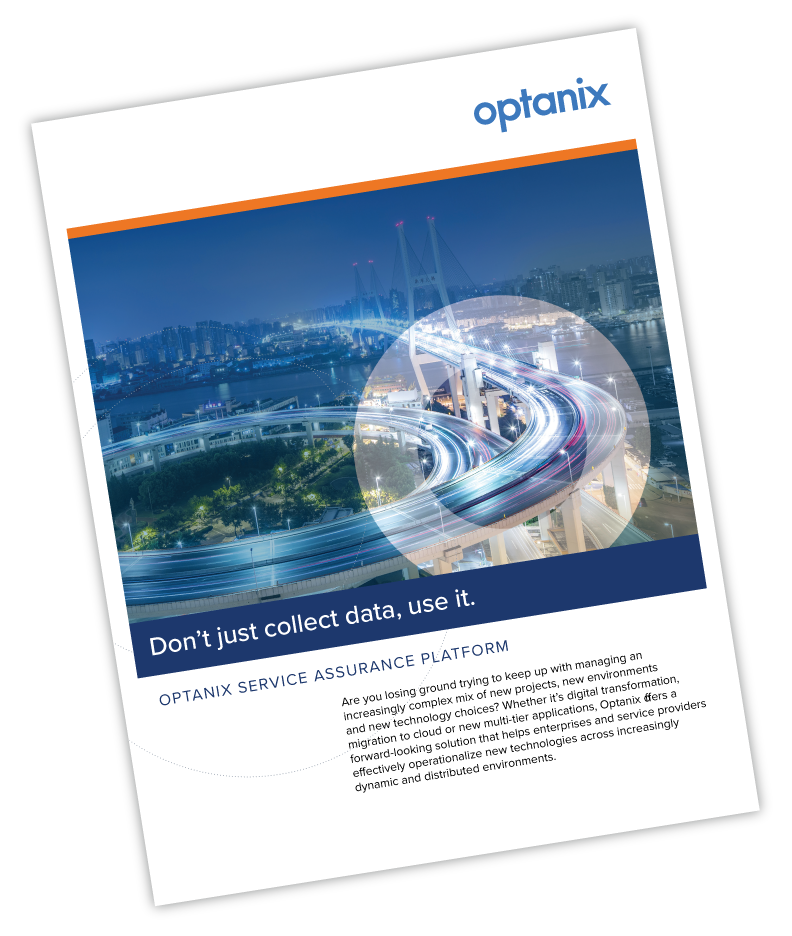
What to Look for in a Service Assurance Solution
The digital transformation of many businesses is now complete. The digital services you provide and the infrastructure that supports them are the very basis upon which your success or failure as a business rests.
But have the systems that ensure the delivery of these services kept up? Are the tools that provide your service assurance capabilities up to the task of managing the infrastructure and meeting the needs of the business?
Discover how to address problems before they impact critical business services.

Key Service Assurance Capabilities
Here are the key service assurance capabilities to consider when looking for an IT operations management platform that will effectively and efficiently ensure the ongoing availability and optimal performance of your business services.
Comprehensive Coverage
The first thing to look for is coverage. Do your service assurance solutions manage your infrastructure in a truly complete fashion? Gaps in visibility directly affect your ability to maintain availability. Look for solutions that provide top-to-bottom, end-to-end, full-stack detection and monitoring capabilities.
Next, look for platforms that consolidate capabilities. This provides a huge operational advantage. The more dispersed your toolsets are, the more time you spend jumping across screens trying to get things done. Consolidation brings immediate benefits, especially in terms of reducing expense and maintenance costs.
Another crucial element is automatic discovery. Platforms that automatically discover managed components and their relationships to each other, both initially when the system is set up and over time, help to remove expensive manual intervention and bring about efficiencies in coverage.
Full-Stack Monitoring Strategy
Once you have a picture of what makes up the delivery infrastructure, you need to know what to look for. Here, full-stack monitoring is key. In order to focus on what’s truly important to performance, it pays to have a platform that can manage the tidal wave of information generated by a network infrastructure.
Full-stack monitoring increases the value of the following prerequisite features. There is a direct correlation between the volume of data that is collected and the accuracy of the results.
- Smart analytics, which looks at data over time and creates dynamic baselines. In addition to presenting these baselines in dashboards and reports, smart analytics can create thresholds based on both deviations from normal and rate of change to escalate based on abnormalities. This can provide trends for predictive analysis and capacity management to warn of impending problems and capacity requirements before they occur.
- Root cause validation. When it comes to remediation, your platform needs to move beyond basic root cause determination. Systems that possess the ability to verify and validate root causes have the potential to bring about incredible efficiencies by avoiding misguided remediation, missed problems and lethargic reaction times.
- Automatic remediation. Next-gen IT operations management platforms need to be able to recommend remediation steps and automatically execute basic proactive steps. They need to maintain and provide access to knowledge bases that enable remediation teams to rapidly get to the steps needed to fix an issue once it’s been identified.
Secure Remote Access
When it comes to reducing downtime, Mean Time to Repair (MTTR) is the metric everyone looks at. This involves the combined effort of people, process and tools. Your operations team depends on efficient processes and capable tools to manage this metric.
Service assurances that streamline access and provide multi-tenant capabilities are key. This allows IT teams to address problems across multiple sites and multiple customers quickly in order to reduce MTTR. Next-gen tools leverage the cloud to provide secure remote access to further maximize operational efficiency.
Built-in automation and workflow capabilities are also essential to reduce unforced human errors when it comes to operational capabilities. They serve as a useful tool to capture and utilize institutional knowledge in a distributed fashion that otherwise might stagnate in isolation.
Situational Awareness of Business Services
What truly matters is not what part of the supporting infrastructure is facing performance issues – it’s what business services are impacted and what audiences they serve.
It is absolutely essential for next-gen service assurance solutions to provide an understanding of the business services as they are tied to the underlying IT infrastructure. Platforms that deliver real-time situational awareness of business services enable IT to prioritize and address issues in order of importance.
This limits the impact to critical business processes and also gives the IT team the information they need to meet SLAs and ensure business services can operate at full capacity.
In addition to mapping the business services to the supporting infrastructure, techniques such as flow analysis are key capabilities. Application flow data can provide context to existing fault and performance data from infrastructure components to produce a more complete view of business services and how they are performing. Smart analytics can build a baseline view of application performance and raise the alarm when things are trending out of spec.
Operations & Management Model Flexibility
In IT operations management, one size does not fit all. As an MSP or as an end user, your needs are unique and highly specific. The service assurance solution you use must be able to meet these needs. In many ways, flexibility is the most important feature of your IT operations management platform.
The platform you use must have the ability to grow and adapt as the needs of your business evolves. Next-gen service assurance platforms must be able to manage hybrid environments and provide the basis to support emerging technologies such as SDx.
Based on the maturity and capability of your organization, you may have the ability to manage the platform yourself, or you may prefer to have the platform provided as a managed service with either co-managed or completely outsourced models. Today’s service assurance platforms support multiple deployment options to cater to the specific needs of your network infrastructure.
Optanix’s New Advanced Service Assurance Solution
Optanix now delivers a “full-stack” performance and availability monitoring solution designed to support contact center and unified communications deployments. This platform provides capabilities across hybrid IT infrastructures with full-stack monitoring, true root cause analysis, business service monitoring, streamlined remediation and management.
Discover how the new capabilities and key benefits of this release can benefit your organization: